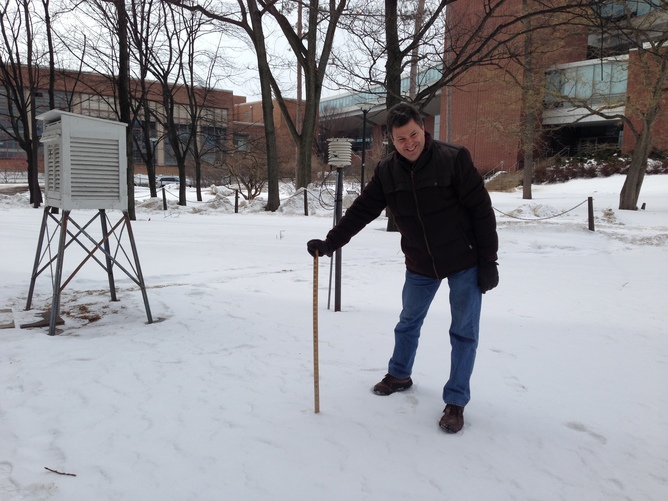Where do those snowfall totals on the nightly news come from?
Earlier this month, Bangor, Maine tied their own record for deepest snow at 53 inches. Mountainous locations will sometimes see triple-digit snow depths.
Impressive numbers for sure, but assuming you have a measuring stick long enough to reach the ground beneath all the white, really, how hard can it be to measure? You stick a ruler or yardstick into the snow and get a number, right? Well, not so fast. It’s a little more complicated than you might think to get those oh-so-important snow totals for winter storms.
Since 1890, the National Weather Service has relied on a network of volunteer observers, all strictly adhering to the NWS guidelines, to come up with snow measurement numbers over a region. There are over 8,700 cooperative observers across the country who send in their weather data to the NWS daily, some who have done it for over 75 years!
Snow measurement is inherently inexact, but attention to one’s surroundings and sticking to the guidelines help those of us who do it on a regular basis stay consistent – and with long-term weather records, consistency is arguably just as important as accuracy.
First, we do need to differentiate between snow depth and snow fall.
How deep is your snow
Snow depth should be a measure of the average depth in a given location and its immediate surroundings. It’s usually rounded to the nearest whole number. To get a representative number, you need a site with minimal drifting (not always easy to find) and several measurements should be averaged to get a final number. I like 10 because it makes the math easy.
Careful measurement is vital so we can make reasonable estimates for the amount of liquid contained in the snowpack. As hard as it is to believe at times, the snow will eventually melt, and rapid melting could cause problems with flooding. Also, hydrologists' models to predict water levels critically depend upon good initial data collection (though improved satellite data has helped reduce their reliance on any individual measurement).
Snow depth is like the sum of individual snowfalls, if one assumes no sublimation – snow turning into water vapor – or melting from the first snowfall until the present day. That assumption would almost always be wrong, of course, but if we suspend reality for a moment, the depth will still never exceed the sum of all snowfalls because snow is compressible. So, two 10.5-inch snowfalls may only accumulate to a depth of 17 inches. It’s the compressibility of snow that causes the greatest consternation and controversy with snowfall measurement.
How much snow did a storm bring
Snowfall is the amount of snow that accumulates during a given time, usually a 24-hour period. In a perfect world this 24-hour period would end at midnight, but the vast majority of National Weather Service cooperative observers take their daily observation in the morning.
To properly measure snowfall, you need a level and flat surface. As with snow depth, measuring snowfall should be unaffected by drifting. The National Weather Service suggests the use of a snowboard, which is a white surface that will absorb very little sunlight and stay close to the ambient air temperature, but any “cold” surface will do. Keeping in mind that consistency is critical, the goal here is to make a measurement that is representative of the surrounding area and consistent with others making snowfall measurements.
Read the full article in THE CONVERSATION:
Where do those snowfall totals on the nightly news come from?

